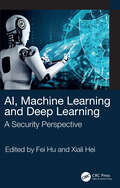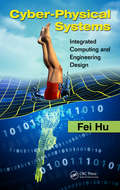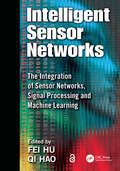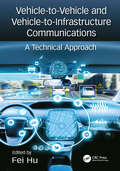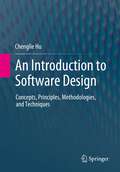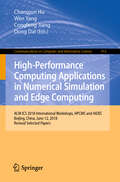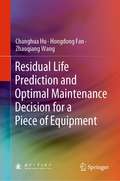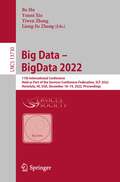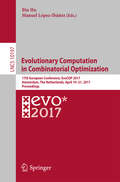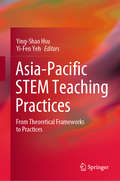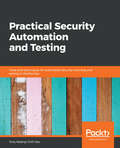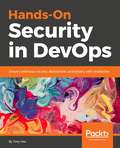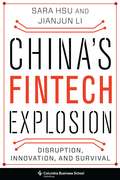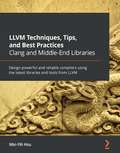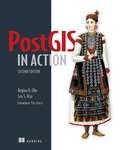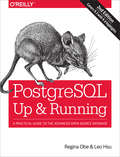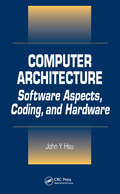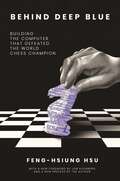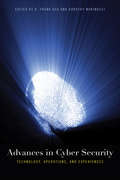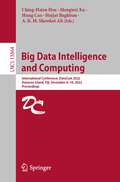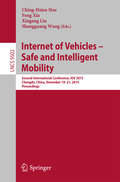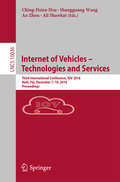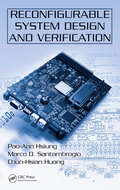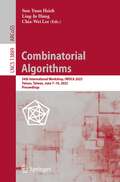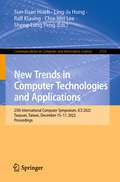- Table View
- List View
AI, Machine Learning and Deep Learning: A Security Perspective
by Fei Hu Xiali HeiToday, Artificial Intelligence (AI) and Machine Learning/ Deep Learning (ML/DL) have become the hottest areas in information technology. In our society, many intelligent devices rely on AI/ML/DL algorithms/tools for smart operations. Although AI/ML/DL algorithms and tools have been used in many internet applications and electronic devices, they are also vulnerable to various attacks and threats. AI parameters may be distorted by the internal attacker; the DL input samples may be polluted by adversaries; the ML model may be misled by changing the classification boundary, among many other attacks and threats. Such attacks can make AI products dangerous to use. While this discussion focuses on security issues in AI/ML/DL-based systems (i.e., securing the intelligent systems themselves), AI/ML/DL models and algorithms can actually also be used for cyber security (i.e., the use of AI to achieve security). Since AI/ML/DL security is a newly emergent field, many researchers and industry professionals cannot yet obtain a detailed, comprehensive understanding of this area. This book aims to provide a complete picture of the challenges and solutions to related security issues in various applications. It explains how different attacks can occur in advanced AI tools and the challenges of overcoming those attacks. Then, the book describes many sets of promising solutions to achieve AI security and privacy. The features of this book have seven aspects: This is the first book to explain various practical attacks and countermeasures to AI systems Both quantitative math models and practical security implementations are provided It covers both "securing the AI system itself" and "using AI to achieve security" It covers all the advanced AI attacks and threats with detailed attack models It provides multiple solution spaces to the security and privacy issues in AI tools The differences among ML and DL security and privacy issues are explained Many practical security applications are covered
Cyber-Physical Systems: Integrated Computing and Engineering Design
by Fei HuThis book supplies comprehensive coverage of the principles and design of CPSs. It addresses the many challenges that must be overcome and outlines a roadmap of how to get there. Covering the most important design theories and modeling methods for a practical CPS, text presents concrete CPS designs for popular civilian applications, including building and energy management.Reflecting the importance of human health care in society, it includes CPS examples of rehabilitation applications such as virtual reality-based disability recovery platforms.
Intelligent Sensor Networks: The Integration of Sensor Networks, Signal Processing and Machine Learning
by Fei HuIn the last decade, wireless or wired sensor networks have attracted much attention. However, most designs target general sensor network issues including protocol stack (routing, MAC, etc.) and security issues. This book focuses on the close integration of sensing, networking, and smart signal processing via machine learning. Based on their world-class research, the authors present the fundamentals of intelligent sensor networks. They cover sensing and sampling, distributed signal processing, and intelligent signal learning. In addition, they present cutting-edge research results from leading experts.
Vehicle-to-Vehicle and Vehicle-to-Infrastructure Communications: A Technical Approach
by Fei HuThis book focuses on the most critical technical aspects of vehicle-to-vehicle (V2V) and vehicle-to-infrastructure (V2I) communications. It covers the smart city concept and architecture and explains how V2V and V2I fit into it. It describes the wireless communication protocols for V2V and V2I. It then explains the hardware design process for vehicle communication transceiver and antenna systems. It explains next-generation wireless technologies and their requirements for vehicle communication protocols. Case studies provide the latest V2V and V2I commercial design details. Finally, it describes how to implement vehicle communication protocol from practical hardware design angle.
An Introduction to Software Design: Concepts, Principles, Methodologies, and Techniques
by Chenglie HuThis textbook provides a balanced coverage on software design, including design principles, methodologies, and techniques in contexts of designing modules of small and larger sizes with a multi-paradigm viewpoint emphasizing design trade-off. Commonly used design diagrams and patterns are also covered in terms of the design ideas behind and their effective use. The book also explores what (software) design thinking is, the role it plays in a design process, and ways to promote it. Despite object orientation being still the center of attention, there is a strong promotion throughout the book that software design should consider all appropriate design paradigms and methodologies.The book is organized in 10 chapters. Chapter 1 is dedicated to an exploration of what software design may be and entail. Next, chapters 2 and 3 are designed to help readers better understand object orientation, and the essentials of object-oriented design. Chapter 4 is then dedicated to the design of methods, while chapters 5, 6, and 8 respectively include topics about the design of objects, modeling with the Unified Modeling Language, and the use of design patterns. Larger software elements are often directly responsible for the formation of software architecture, thus chapter 7 covers four kinds of larger software elements: libraries, components, frameworks, and microservices, and their architectural implications. Chapter 9 finally brings the presentation of software design to an end with a coverage on software architecture focusing on software architectural views. Case studies are important in learning how to design software, hence chapter 10 then gathers some small design case studies that can be used in earlier chapters as appropriate. These case studies can be extended in different ways to provide additional design opportunities.This textbook book is intended for a junior level undergraduate course on software design, yet the depth of the book makes it also appropriate for a design course at beginning graduate level. Professionals may also find the book useful in their professional development.
High-Performance Computing Applications in Numerical Simulation and Edge Computing: ACM ICS 2018 International Workshops, HPCMS and HiDEC, Beijing, China, June 12, 2018, Revised Selected Papers (Communications in Computer and Information Science #913)
by Changjun Hu Wen Yang Congfeng Jiang Dong DaiThis book constitutes the referred proceedings of two workshops held at the 32nd ACM International Conference on Supercomputing, ACM ICS 2018, in Beijing, China, in June 2018. This volume presents the papers that have been accepted for the following workshops: Second International Workshop on High Performance Computing for Advanced Modeling and Simulation in Nuclear Energy and Environmental Science, HPCMS 2018, and First International Workshop on HPC Supported Data Analytics for Edge Computing, HiDEC 2018. The 20 full papers presented during HPCMS 2018 and HiDEC 2018 were carefully reviewed and selected from numerous submissions. The papers reflect such topics as computing methodologies; parallel algorithms; simulation types and techniques; machine learning.
Residual Life Prediction and Optimal Maintenance Decision for a Piece of Equipment
by Changhua Hu Hongdong Fan Zhaoqiang WangThis book addresses remaining life prediction and predictive maintenance of equipment. It systematically summarizes the key research findings made by the author and his team and focuses on how to create equipment performance degradation and residual life prediction models based on the performance monitoring data produced by currently used and historical equipment. Some of the theoretical results covered here have been used to make remaining life predictions and maintenance-related decisions for aerospace products such as gyros and platforms. Given its scope, the book offers a valuable reference guide for those pursuing theoretical or applied research in the areas of fault diagnosis and fault-tolerant control, remaining life prediction, and maintenance decision-making.
Big Data – BigData 2022: 11th International Conference, Held as Part of the Services Conference Federation, SCF 2022, Honolulu, HI, USA, December 10–14, 2022, Proceedings (Lecture Notes in Computer Science #13730)
by Bo Hu Yunni Xia Yiwen Zhang Liang-Jie ZhangThis book constitutes the proceedings of the 11th International Conference on Big Data, BigData 2022, held as part of the Services Conference Federation, SCF 2022, held in Honolulu, HI, USA, in December 2022. The 4 full papers and 5 short papers presented in this volume were carefully reviewed and selected from 16 submissions.The 2022 International Congress on Big Data (BigData 2022) aims to provide an international forum that formally explores various business insights of all kinds of value-added "services". Big Data is a key enabler of exploring business insights and economics of services.
Evolutionary Computation in Combinatorial Optimization
by Bin Hu Manuel López-IbáñezThis book constitutes the refereed proceedings of the 16th European Conference on Evolutionary Computation in Combinatorial Optimization, EvoCOP 2016, held in Porto, Portugal, in March/April 2016, co-located with the Evo*2015 events EuroGP, EvoMUSART and EvoApplications. The 17 revised full papers presented were carefully reviewed and selected from 44 submissions. The papers cover methodology, applications and theoretical studies. The methods included evolutionary and memetic algorithms, variable neighborhood search, particle swarm optimization, hyperheuristics, mat-heuristic and other adaptive approaches. Applications included both traditional domains, such as graph coloring, vehicle routing, the longest common subsequence problem, the quadratic assignment problem; and new(er) domains such as the traveling thief problem, web service location, and finding short addition chains. The theoretical studies involved fitness landscape analysis, local search and recombination operator analysis, and the big valley search space hypothesis. The consideration of multiple objectives, dynamic and noisy environments was also present in a number of articles.
Asia-Pacific STEM Teaching Practices: From Theoretical Frameworks to Practices
by Ying-Shao Hsu Yi-Fen YehThis book offers various perspectives on the complex and crosscutting concepts of the science, technology, engineering, and mathematics (STEM) disciplines in the classroom context. Presenting empirical studies, it reveals how researchers in the Asia-Pacific Region planned and implemented STEM education in the classroom. Further, it discusses the assessment of STEM learning to clarify what important elements should be included and how researchers and educators frame and design assessment tools. The book consists of four parts: potential and trends in STEM education; teachers’ practical knowledge for STEM teaching; STEM teaching practices; and assessment of STEM learning. Providing evidence on developing curriculums, implementing instructional practices and educating classroom teachers, it is intended for readers wanting to explore STEM education from multiple perspectives.
Practical Security Automation and Testing: Tools and techniques for automated security scanning and testing in DevSecOps
by Tony Hsiang-Chih HsuYour one stop guide to automating infrastructure security using DevOps and DevSecOpsKey FeaturesSecure and automate techniques to protect web, mobile or cloud servicesAutomate secure code inspection in C++, Java, Python, and JavaScriptIntegrate security testing with automation frameworks like fuzz, BDD, Selenium and Robot FrameworkBook DescriptionSecurity automation is the automatic handling of software security assessments tasks. This book helps you to build your security automation framework to scan for vulnerabilities without human intervention.This book will teach you to adopt security automation techniques to continuously improve your entire software development and security testing. You will learn to use open source tools and techniques to integrate security testing tools directly into your CI/CD framework. With this book, you will see how to implement security inspection at every layer, such as secure code inspection, fuzz testing, Rest API, privacy, infrastructure security, and web UI testing. With the help of practical examples, this book will teach you to implement the combination of automation and Security in DevOps. You will learn about the integration of security testing results for an overall security status for projects.By the end of this book, you will be confident implementing automation security in all layers of your software development stages and will be able to build your own in-house security automation platform throughout your mobile and cloud releases.What you will learnAutomate secure code inspection with open source tools and effective secure code scanning suggestionsApply security testing tools and automation frameworks to identify security vulnerabilities in web, mobile and cloud servicesIntegrate security testing tools such as OWASP ZAP, NMAP, SSLyze, SQLMap, and OpenSCAPImplement automation testing techniques with Selenium, JMeter, Robot Framework, Gauntlt, BDD, DDT, and Python unittestExecute security testing of a Rest API Implement web application security with open source tools and script templates for CI/CD integrationIntegrate various types of security testing tool results from a single project into one dashboardWho this book is forThe book is for software developers, architects, testers and QA engineers who are looking to leverage automated security testing techniques.
Hands-On Security in DevOps: Ensure continuous security, deployment, and delivery with DevSecOps
by Tony HsuProtect your organization's security at all levels by introducing the latest strategies for securing DevOpsKey FeaturesIntegrate security at each layer of the DevOps pipelineDiscover security practices to protect your cloud services by detecting fraud and intrusionExplore solutions to infrastructure security using DevOps principlesBook DescriptionDevOps has provided speed and quality benefits with continuous development and deployment methods, but it does not guarantee the security of an entire organization. Hands-On Security in DevOps shows you how to adopt DevOps techniques to continuously improve your organization’s security at every level, rather than just focusing on protecting your infrastructure.This guide combines DevOps and security to help you to protect cloud services, and teaches you how to use techniques to integrate security directly in your product. You will learn how to implement security at every layer, such as for the web application, cloud infrastructure, communication, and the delivery pipeline layers. With the help of practical examples, you’ll explore the core security aspects, such as blocking attacks, fraud detection, cloud forensics, and incident response. In the concluding chapters, you will cover topics on extending DevOps security, such as risk assessment, threat modeling, and continuous security.By the end of this book, you will be well-versed in implementing security in all layers of your organization and be confident in monitoring and blocking attacks throughout your cloud services.What you will learnUnderstand DevSecOps culture and organizationLearn security requirements, management, and metricsSecure your architecture design by looking at threat modeling, coding tools and practicesHandle most common security issues and explore black and white-box testing tools and practicesWork with security monitoring toolkits and online fraud detection rulesExplore GDPR and PII handling case studies to understand the DevSecOps lifecycleWho this book is forHands-On Security in DevOps is for system administrators, security consultants, and DevOps engineers who want to secure their entire organization. Basic understanding of Cloud computing, automation frameworks, and programming is necessary.
China's Fintech Explosion: Disruption, Innovation, and Survival
by Sara Hsu Jianjun LiFinancial technology—or fintech—is gaining in popularity globally as a way of making financial services more efficient and accessible. In rapidly developing China, fintech is taking off, catering to markets that state-owned banks and an undersized financial sector do not serve amid a backdrop of growing consumption and a large, tech-savvy millennial generation. It is becoming increasingly likely that some of China’s fintech firms will change the way the world does business.In China’s Fintech Explosion, Sara Hsu and Jianjun Li explore the transformative potential of China’s financial-technology industry, describing the risks and rewards for participants as well as the impact on consumers. They cover fintech’s many subsectors, such as digital payment systems, peer-to-peer lending and crowdfunding, credit card issuance, internet banks, blockchain finance and virtual currencies, and online insurance. The book highlights the disruption of traditional banking as well as the risks of fintech and regulatory technology. Hsu and Li describe major companies including Alipay and Tencent, developer of WeChat Pay and a wealth-management business, and other leading fintech firms such as Creditease, Zhong An Insurance, and JD Finance. Offering expert analysis of market potential, risks, and competition, as well as case studies of firms and consumer behavior, China’s Fintech Explosion is a must-read for anyone interested in one of the world’s breakout sectors.
LLVM Techniques, Tips, and Best Practices Clang and Middle-End Libraries: Design powerful and reliable compilers using the latest libraries and tools from LLVM
by Min-Yih HsuLearn how you can build the next big programming language, compiler, or source code analyzer using LLVM and ClangKey FeaturesExplore Clang, LLVM's middle-end and backend, in a pragmatic wayDevelop your LLVM skillset and get to grips with a variety of common use casesEngage with real-world LLVM development through various coding examplesBook DescriptionEvery programmer or engineer, at some point in their career, works with compilers to optimize their applications. Compilers convert a high-level programming language into low-level machine-executable code. LLVM provides the infrastructure, reusable libraries, and tools needed for developers to build their own compilers. With LLVM's extensive set of tooling, you can effectively generate code for different backends as well as optimize them. In this book, you'll explore the LLVM compiler infrastructure and understand how to use it to solve different problems. You'll start by looking at the structure and design philosophy of important components of LLVM and gradually move on to using Clang libraries to build tools that help you analyze high-level source code. As you advance, the book will show you how to process LLVM IR – a powerful way to transform and optimize the source program for various purposes. Equipped with this knowledge, you'll be able to leverage LLVM and Clang to create a wide range of useful programming language tools, including compilers, interpreters, IDEs, and source code analyzers. By the end of this LLVM book, you'll have developed the skills to create powerful tools using the LLVM framework to overcome different real-world challenges.What you will learnFind out how LLVM's build system works and how to reduce the building resourceGet to grips with running custom testing with LLVM's LIT frameworkBuild different types of plugins and extensions for ClangCustomize Clang's toolchain and compiler flagsWrite LLVM passes for the new PassManagerDiscover how to inspect and modify LLVM IRUnderstand how to use LLVM's profile-guided optimizations (PGO) frameworkCreate custom compiler sanitizersWho this book is forThis book is for software engineers of all experience levels who work with LLVM. If you are an academic researcher, this book will help you learn useful LLVM skills in a short time and enable you to build your prototypes and projects quickly. Programming language enthusiasts will also find this book useful for building a new programming language with the help of LLVM.
PostGIS in Action
by Leo S. Hsu Regina O. ObeSummaryPostGIS in Action, Second Edition teaches readers of all levels to write spatial queries that solve real-world problems. It first gives you a background in vector-, raster-, and topology-based GIS and then quickly moves into analyzing, viewing, and mapping data. This second edition covers PostGIS 2.0 and 2.1 series, PostgreSQL 9.1, 9.2, and 9.3 features, and shows you how to integrate with other GIS tools.Purchase of the print book includes a free eBook in PDF, Kindle, and ePub formats from Manning Publications.About the BookProcessing data tied to location and topology requires specialized know-how. PostGIS is a free spatial database extender for PostgreSQL, every bit as good as proprietary software. With it, you can easily create location-aware queries in just a few lines of SQL code and build the back end for a mapping, raster analysis, or routing application with minimal effort.PostGIS in Action, Second Edition teaches you to solve real-world geodata problems. It first gives you a background in vector-, raster-, and topology-based GIS and then quickly moves into analyzing, viewing, and mapping data. You'll learn how to optimize queries for maximum speed, simplify geometries for greater efficiency, and create custom functions for your own applications. You'll also learn how to apply your existing GIS knowledge to PostGIS and integrate with other GIS tools.Familiarity with relational database and GIS concepts is helpful but not required.What's InsideAn introduction to spatial databasesGeometry, geography, raster, and topology spatial types, functions, and queriesApplying PostGIS to real-world problemsExtending PostGIS to web and desktop applicationsUpdated for PostGIS 2.x and PostgreSQL 9.xAbout the AuthorsRegina Obe and Leo Hsu are database consultants and authors. Regina is a member of the PostGIS core development team and the Project Steering Committee.Table of ContentsPART 1 INTRODUCTION TO POSTGISWhat is a spatial database?Spatial data typesSpatial reference system considerationsWorking with real dataUsing PostGIS on the desktopGeometry and geography functionsRaster functionsPostGIS TIGER geocoderGeometry relationshipsPART 2 PUTTING POSTGIS TO WORKProximity analysisGeometry and geography processingRaster processingBuilding and using topologiesOrganizing spatial dataQuery performance tuningPART 3 USING POSTGIS WITH OTHER TOOLSExtending PostGIS with pgRouting and procedural languagesUsing PostGIS in web applications
PostgreSQL: Up and Running
by Leo S. Hsu Regina O. ObeThinking of migrating to PostgreSQL? This clear, fast-paced introduction helps you understand and use this open source database system. Not only will you learn about the enterprise class features in versions 9.2, 9.3, and 9.4, you'll also discover that PostgeSQL is more than a database system--it's also an impressive application platform.With examples throughout, this book shows you how to achieve tasks that are difficult or impossible in other databases. This second edition covers LATERAL queries, augmented JSON support, materialized views, and other key topics. If you're a current PostgreSQL user, you'll pick up gems you may have missed before.Learn basic administration tasks such as role management, database creation, backup, and restoreApply the psql command-line utility and the pgAdmin graphical administration toolExplore PostgreSQL tables, constraints, and indexesLearn powerful SQL constructs not generally found in other databasesUse several different languages to write database functionsTune your queries to run as fast as your hardware will allowQuery external and variegated data sources with foreign data wrappersLearn how use built-in replication filters to replicate data
Computer Architecture: Software Aspects, Coding, and Hardware (Telecommunications And Networking Library)
by John Y. HsuWith the new developments in computer architecture, fairly recent publications can quickly become outdated. Computer Architecture: Software Aspects, Coding, and Hardware takes a modern approach. This comprehensive, practical text provides that critical understanding of a central processor by clearly detailing fundamentals, and cutting edge design features. With its balanced software/hardware perspective and its description of Pentium processors, the book allows readers to acquire practical PC software experience. The text presents a foundation-level set of ideas, design concepts, and applications that fully meet the requirements of computer organization and architecture courses.The book features a "bottom up" computer design approach, based upon the author's thirty years experience in both academe and industry. By combining computer engineering with electrical engineering, the author describes how logic circuits are designed in a CPU. The extensive coverage of a micprogrammed CPU and new processor design features gives the insight of current computer development. Computer Architecture: Software Aspects, Coding, and Hardware presents a comprehensive review of the subject, from beginner to advanced levels. Topics include:o Two's complement numbers o Integer overflow o Exponent overflow and underflow o Looping o Addressing modes o Indexing o Subroutine linking o I/O structures o Memory mapped I/O o Cycle stealing o Interrupts o Multitasking o Microprogrammed CPU o Multiplication tree o Instruction queue o Multimedia instructions o Instruction cache o Virtual memory o Data cache o Alpha chip o Interprocessor communications o Branch prediction o Speculative loading o Register stack o JAVA virtual machine o Stack machine principles
Behind Deep Blue: Building the Computer That Defeated the World Chess Champion
by Feng-hsiung HsuThe riveting quest to construct the machine that would take on the world’s greatest human chess player—told by the man who built itOn May 11, 1997, millions worldwide heard news of a stunning victory, as a machine defeated the defending world chess champion, Garry Kasparov. Behind Deep Blue tells the inside story of the quest to create the mother of all chess machines and what happened at the two historic Deep Blue vs. Kasparov matches. Feng-hsiung Hsu, the system architect of Deep Blue, reveals how a modest student project started at Carnegie Mellon in 1985 led to the production of a multimillion-dollar supercomputer. Hsu discusses the setbacks, tensions, and rivalries in the race to develop the ultimate chess machine, and the wild controversies that culminated in the final triumph over the world's greatest human player. With a new foreword by Jon Kleinberg and a new preface from the author, Behind Deep Blue offers a remarkable look at one of the most famous advances in artificial intelligence, and the brilliant toolmaker who invented it.
Advances in Cyber Security: Technology, Operations, and Experiences
by D. Frank Hsu Dorothy MarinucciAs you read this, your computer is in jeopardy of being hacked and your identity being stolen. Read this book to protect yourselves from this threat. The world’s foremost cyber security experts, from Ruby Lee, Ph.D., the Forrest G. Hamrick professor of engineering and Director of the Princeton Architecture Laboratory for Multimedia and Security (PALMS) at Princeton University; to Nick Mankovich, Chief Information Security Officer of Royal Philips Electronics; to FBI Director Robert S. Mueller III; to Special Assistant to the President Howard A. Schmidt, share critical practical knowledge on how the cyberspace ecosystem is structured, how it functions, and what we can do to protect it and ourselves from attack and exploitation. The proliferation of social networking and advancement of information technology provide endless benefits in our living and working environments. However, these benefits also bring horrors in various forms of cyber threats and exploitations. Advances in Cyber Security collects the wisdom of cyber security professionals and practitioners from government, academia, and industry across national and international boundaries to provide ways and means to secure and sustain the cyberspace ecosystem. Readers are given a first-hand look at critical intelligence on cybercrime and security—including details of real-life operations. The vast, useful knowledge and experience shared in this essential new volume enables cyber citizens and cyber professionals alike to conceive novel ideas and construct feasible and practical solutions for defending against all kinds of adversaries and attacks. Among the many important topics covered in this collection are building a secure cyberspace ecosystem; public–private partnership to secure cyberspace; operation and law enforcement to protect our cyber citizens and to safeguard our cyber infrastructure; and strategy and policy issues to secure and sustain our cyber ecosystem.
Big Data Intelligence and Computing: International Conference, DataCom 2022, Denarau Island, Fiji, December 8–10, 2022, Proceedings (Lecture Notes in Computer Science #13864)
by Ching-Hsien Hsu Mengwei Xu Hung Cao Hojjat Baghban A. B. M. Shawkat AliThis book constitutes the proceedings of the International Conference on Big Data Intelligence and Computing, DataCom 2022, which took place in Denarau Island, Fiji, in December 2022. The 30 full papers included in this volume were carefully reviewed and selected from 88 submissions. The papers detail big data analytics solutions, distributed computation paradigms, on-demand services, autonomic systems, and pervasive applications.
Internet of Vehicles - Safe and Intelligent Mobility
by Ching-Hsien Hsu Feng Xia Xingang Liu Shangguang WangThis book constitutes the refereed proceedings of the Second International Conference on Internet of Vehicles, IOV 2015, held in Chengdu, China, in December 2015. The 40 full papers presented were carefully reviewed and selected from 128 submissions. They focus on the following topics: IOV architectures and applications; intelligent mobility; V2V and M2M communications; and modeling and simulations.
Internet of Vehicles – Technologies and Services
by Ching-Hsien Hsu Shangguang Wang Ao Zhou Ali ShawkatThis book constitutes the refereed proceedings of the Third International Conference on Internet of Vehicles, IOV 2016, held in Nadi, Fiji, in December 2016. The 22 full papers presented were carefully reviewed and selected from 55 submissions. IOV 2016 is intended to play an important role for researchers and industry practitioners to exchange information regarding advancements in the state of art and practice of IOV architectures, protocols, services, and applications, as well as to identify emerging research topics and define the future directions of IOV.
Reconfigurable System Design and Verification
by Pao-Ann Hsiung Marco D. Santambrogio Chun-Hsian HuangReconfigurable systems have pervaded nearly all fields of computation and will continue to do so for the foreseeable future. Reconfigurable System Design and Verification provides a compendium of design and verification techniques for reconfigurable systems, allowing you to quickly search for a technique and determine if it is appropriate to the task at hand. It bridges the gap between the need for reconfigurable computing education and the burgeoning development of numerous different techniques in the design and verification of reconfigurable systems in various application domains. The text explains topics in such a way that they can be immediately grasped and put into practice. It starts with an overview of reconfigurable computing architectures and platforms and demonstrates how to develop reconfigurable systems. This sets up the discussion of the hardware, software, and system techniques that form the core of the text. The authors classify design and verification techniques into primary and secondary categories, allowing the appropriate ones to be easily located and compared. The techniques discussed range from system modeling and system-level design to co-simulation and formal verification. Case studies illustrating real-world applications, detailed explanations of complex algorithms, and self-explaining illustrations add depth to the presentation. Comprehensively covering all techniques related to the hardware-software design and verification of reconfigurable systems, this book provides a single source for information that otherwise would have been dispersed among the literature, making it very difficult to search, compare, and select the technique most suitable. The authors do it all for you, making it easy to find the techniques that fit your system requirements, without having to surf the net or digital libraries to find the candidate techniques and compare them yourself.
Combinatorial Algorithms: 34th International Workshop, IWOCA 2023, Tainan, Taiwan, June 7–10, 2023, Proceedings (Lecture Notes in Computer Science #13889)
by Sun-Yuan Hsieh Ling-Ju Hung Chia-Wei LeeThis book constitutes the refereed proceedings of the 34th International Workshop on Combinatorial Algorithms, IWOCA 2023, held in Tainan, Taiwan, during June 7–10, 2023. The 33 full papers included in this book were carefully reviewed and selected from 86 submissions. They were organized in topical sections as follows: algorithms and data structures; algorithmic and combinatorical aspects of cryptography and information security; algorithmic game theory and complexity of games; approximation algorithms; complexity theory; combinatorics and graph theory; combinatorial generation, enumeration and counting; combinatorial optimization; combinatorics of words; computational biology; computational geometry; decompositions and combinatorial designs; distributed and network algorithms; experimental combinatorics; fine-grained complexity; graph algorithms and modelling with graphs; graph drawing and graph labelling; network theory and temporal graphs; quantum computing and algorithms for quantum computers; online algorithms; parameterized and exact algorithms; probabilistic and randomized algorithms; and streaming algorithms.
New Trends in Computer Technologies and Applications: 25th International Computer Symposium, ICS 2022, Taoyuan, Taiwan, December 15–17, 2022, Proceedings (Communications in Computer and Information Science #1723)
by Sun-Yuan Hsieh Ling-Ju Hung Ralf Klasing Chia-Wei Lee Sheng-Lung PengThis book constitutes the refereed proceedings of the 25th International Computer Symposium on New Trends in Computer Technologies and Applications, ICS 2022, which took place in Taoyuan, Taiwan, in December 2022. ICS is one of the largest joint international IT symposia held in Taiwan. Founded in 1973, it is intended to provide a forum for researchers, educators, and professionals to exchange their discoveries and practices, and to explore future trends and applications in computer technologies. The biannual symposium offers a great opportunity to share research experiences and to discuss potential new trends in the IT industry.The 58 full papers and one invited paper presented in this volume were carefully reviewed and selected from 137 submissions. The papers have been organized in the following topical sections: Invited Paper; Algorithms, Bioinformatics, and Computation Theory; Cloud Computing and Big Data; Computer Vision and Image Processing; Cryptography and Information Security; Electronics and Information Technology; Mobile Computation and Wireless Communication; Ubiquitous Cybersecurity and Forensics.
